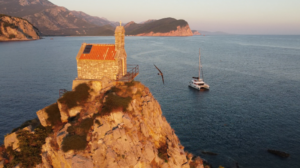In the interview that Zeilwereld held with us in 2023, journalist Riemer Witteveen asked us the question: ‘Name something you really can’t miss on the boat!’. We answered, it was challenging to only mention 1 thing, but we did 😉. This question still stuck in my head later: what could I really not live without? On a boat you have limited space. Everything you carry on the boat also slows down sailing. So we live on less in our tiny house. And it is striking how little you actually need, instead of a lot.
But what do I really not want to miss on the boat? Suppose you have to make a top 10?
Then I immediately think of things in these 3 categories:
– Sailing supplies, such as our jib
– Tools, such as tie-wraps
– Comfort items, such as an electric hob.
Our final top 10 below was been created from those 3 categories! I hope you find it interesting, in case you are considering traveling/sailing yourself:
1. Sails
Of course! Our means of moving forward. You can also travel like a motorboat on diesel, but if, like us, you have traveled almost 10,000 nautical miles (1 nautical mile = 1.8 land kilometers), then with 2 engines and a ship that weighs 15 tons, that would be a become expensive. Diesel is now €2 per liter.
And for us it is also part of the travel experience and the sailing sport that you hoist the sails when you have enough wind. It is great to be wonderfully driven by the wind that billows the sails. The best moment is when you turn off the engines and sail only on the wind and hear the sound of the waves behind your boat.


We have 4 sails (from small to large): jib, mainsail, code-zero and parasail. The jib serves to keep the pressure on the tip of the ship, so that you can steer better. The mainsail is to convert the large gusts of wind into speed. You use the code-zero when the wind is below 18 knots (wind force 2) and you actually have too little wind to gain speed, this large sail reaches from the front to the back of the boat. And the parasail is likea gigantic kite: when the wind comes from behind, this sail is wonderful to pull you along.
2. Solar panels
You still use quite a bit of electricity when sailing or travelling. If you mindlessly plug in the plug at home, you won’t notice. Especially when we anchor, we become very aware of power consumption: hot water, laundry, showering. Everything needs energy.
But ‘energy’ is also available in the sky for us to use: in the summer with sometimes 16 hours of sunshine per day. To avoid expensive shore power, often supplied via fossil fuels, we are very happy with the 5 solar panels we have. Gilles designed the solar rack himself, it can be adjusted to the angle of the sun and is attached at the end of our boat, so it also gives shelter from the sun to the dingue.


The batteries ensure that we can live on stock for at least 3 days without sun and our record in the summer is 12 days without shore power, so charging every day via the solar panels. We also notice that, given the high energy prices, ports sometimes charge an extra surcharge for using electricity in a day, on top of the harbor fee itself. Sometimes up € 20 per day.
3. Tools
Gilles has at least 10 plastic boxes with tools in the boat’s storage, but we are very happy to have those! Just that one key to get the element out of the boiler, very nice to have O-rings onboard to stop leaks on a screw. And a person cannot do without tie wraps on a boat to properly secure things that come loose until the next port!

A sailor once said to me: ‘If you sail on salt water, everything will be destroyed!’. I then laughed a bit nervously and thought: we have bought a brandnew polyester boat, hopefully that will not be too bad. Well, no, even the stands of your e-bike rust away or the lock of your door spontaneously falls down (ofcourse when it is locked!) due to the salty wind. Crazy! So to get things loose again, tools are essential.
4. WiFi
Well, we live in 2024, don’t we! Especially for us being Digital Nomads, who finance travel by working online, good WiFi is crucial. We therefore do not leave our WiFi connection to chance (read: use the WiFi of the ports or a city), but have our own 4G router on board with an extra long antenna. For example, by buying a local SIM card (here in Italy 22 euros for unlimited data), we can check in at all telephone poles in the area of 18 kilometers.


So it rarely happened (about 1 in 300 times) that we had no internetconnection. We happen to be in a nature reserve in Norway at that moment.
Not only the hardware is important, but also software, such as MS Teams, Zoom, Dropbox, ChatGPT, Netflix, KPN and Chromecast. This way we can view the information we need 24 hours a day without any worries.
5. Good company
This one should actually be number 1! It is great to share the joy of sailing with friends and family. In 2023 about 10 weeks we had guests.

The best company we have is each other. I wouldn’t have wanted to make this trip without Gilles. To hang out together, to learn together and laugh about our mistakes, to experience nice surprises such as being invited to eat at people’s homes, but also experience a bit scary things (sailing through the rocks at night): a buddy on whom you can rely is crucial. You can express your thoughts, share doubts, but also experience beautiful moments together when dolphins jump in front of your boat. Or getting a bit tipsy if you can visit a Gin distillery, but only at 11:00 in the morning….
Staying on a boat is a pressure cooker to get to know each other better, because everything is magnified: your good qualities and less good qualities. There is no escape on a boat: you sit together on 12 meters x 8 meters all the time. You see and notice everything about each other. I have come to appreciate Gilles even more, for all the cool things he dares and does and his social attitude towards others, the confidence he has in himself and others. Gilles recently said: “We have only grown closer together.”
6. Good mood
Yes, I really can’t live without that!

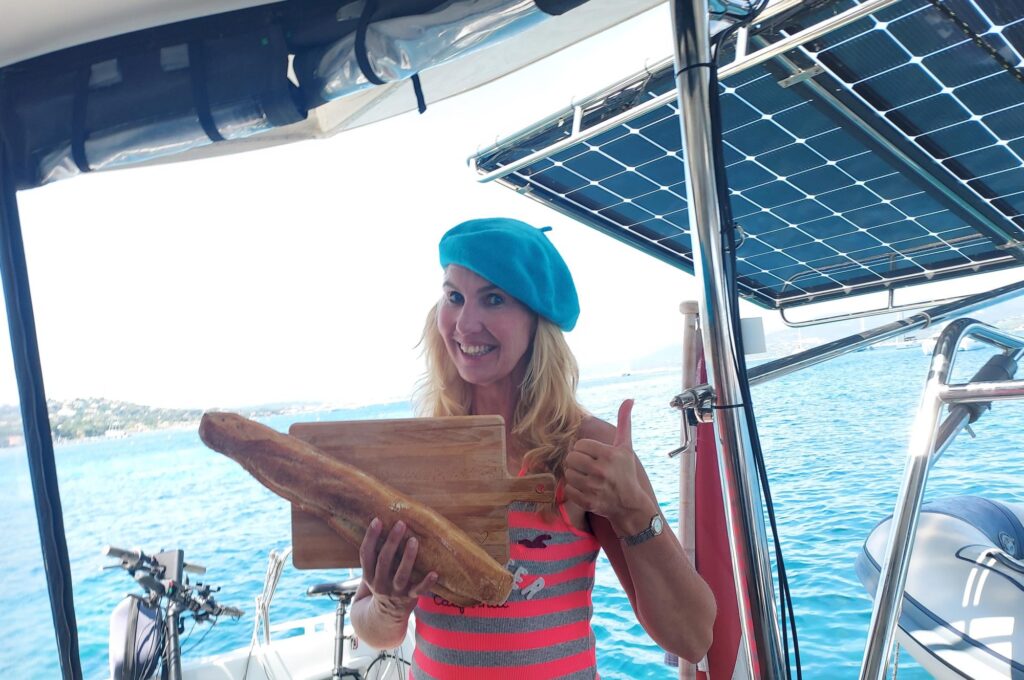
Sailing to me is very similar to entrepreneurship: turning an exciting situation into an opportunity. You spend the whole day trying to maintain your essential existence on the water: is the boat safe on the waves of this bay, do we have enough water, electricity, are we visible at night, why has this broken down again or why does this port refuse us as a catamaran, why is the wind suddenly 8 knots instead of the predicted 30 knots.
You get a crash course in getting flexible and turn unpleasant situations into opportunities. Oh, our sail is torn, well, we always wanted to apply a UV-resistant layer and some nice colors, now that’s a great opportunity to do so! My motto has also become: you make a plan….to deviate from it. Because as a sailor you know one thing for sure: your sailing plan for that day will certainly not go 100% as you planned. Sailors also call this: ‘Plans are made written in the sand at low tide’. Sailing plans are fragile, easily broken by multiple factors.
And yet these are all ‘first world problems’, because we have so much freedom in this lifestyle, really organizing your own day with work/no work, being outside and meeting new cultures and, above all, no rush. If you are in a hurry when travelling, you will more quickly get into a bad mood. I’ve seen this happening when I’m waiting for the train in the Netherlands and a 5-minute delay is announced: people immediately turn their eyes in annoyance, hands in the air, start calling other people to complain. Because everyone plans their agenda to capacity. And the greatest chance of accidents when sailing is if you have tied yourself down with a plan (‘that’s where I have to be today!’), because nature cannot be planned and certainly wind does not keep to its own prediction. So if I got grumpy every time a plan didn’t work out in this lifestyle, I would be in a bad mood a lot 😉. It’s rather the other way around: hey, the sun is shining, how nice, we’ll have hot water again soon!
One of the first things we agreed on: we will do this trip without a deadline, because we have been working with deadlines all our lives. It gives you that rat race feeling and not real freedom. Even ‘being relaxed’ still has to be planned (‘this time yoga, because I-need-to-relax-now!’).
We wanted to count up, not count down.
So far we are in good harmony when it comes to: should we stay here for a few more days with the boat or I feel like leaving again, do you? And if one of us wants a stationary bed and endless hot water more and more, then we should talk about The Return together. But for now, our home is the boat and we really enjoy the adventurous life!
7. E-bike and e-scooter
We also encounter hardcore sailors who do not have bicycles on board: ‘that weighs too much’. So you see them walking around the harbor, taking the bus, taking the taxi.
We notice that the sporty aspect of riding a bike gives us a lot of freedom and allows us to enjoy the outdoors.
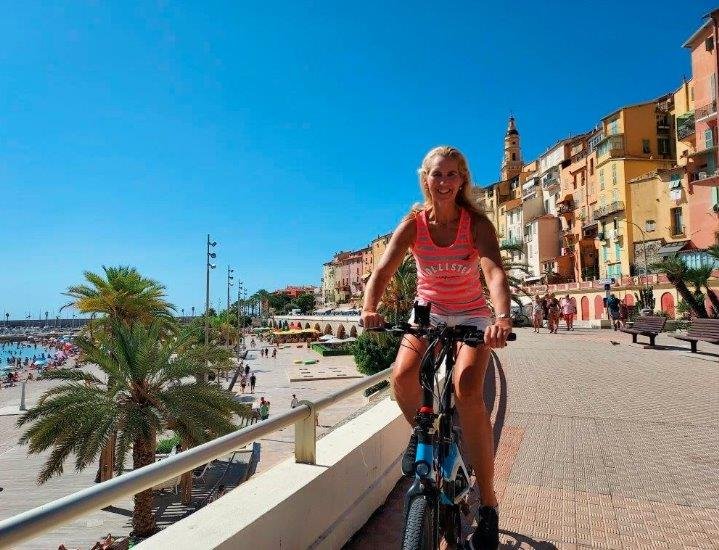
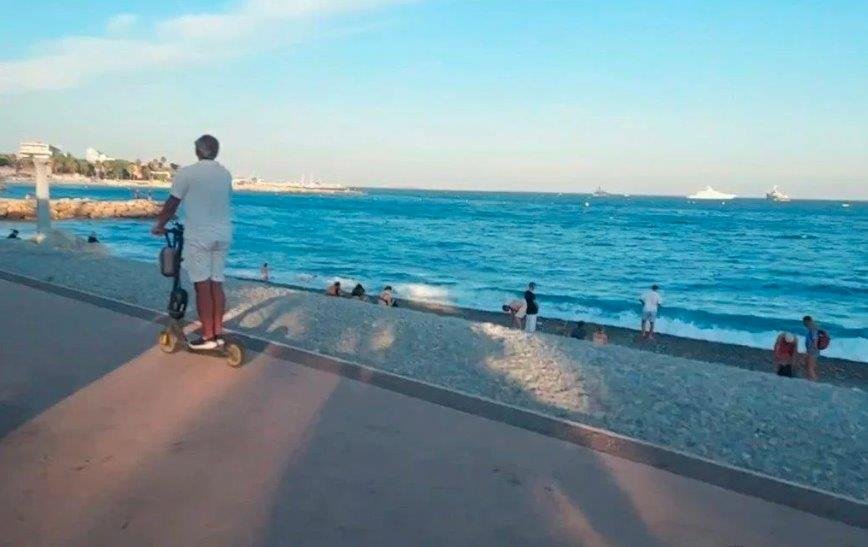
We have an extra battery on our E-bike and e-scooter, so that we can go for at least 60 km without charging. Once we wanted to visit the Dali museum, which was 35 km one way. Then we will have a nice lunch on the way and ask if we can charge the bike (all that is needed is a plug) or we will ask the museum if we can charge it (which they did). That is almost always possible!
You cannot stop where you want from a bus and taxis may once have been cheap in Southern Europe, but we notice that is no longer the case.
We have experienced that in countries other than the Netherlands or Germany, cyclists are not often seen on the road surface. So often the cycle paths are poorly maintained, full of tree stumps or simply no cycle path, then you end up on the motorway. Motorists find that a bit too exciting, in Norway we had 20 cars that drove in a column behind us because they did not dare to overtake us.
Sometimes locals underestimate how far we can go with the E-bike: ‘Yes, there is a castle, but that is at least 10 km away, you won’t make it.’ Watch us! Or in Scotland it was often said: ‘But you can only walk there, you can’t cycle’. We can also turn our e-bike into a mountain bike 😉. And okay, admittedly, we also got stuck in the mud sometimes 😊.
8. Navigational tools
Perhaps not the sexiest thing, but an automatic pilot on the boat really helped us on long trips (think of sailing for 48 hours, so 2 nights) to stay on course and stay fit. Because actively steering yourself, with the forces of currents and waves on your arms, is quite challenging. Sometimes steering yourself is necessary, because otherwise the boat will move too much.
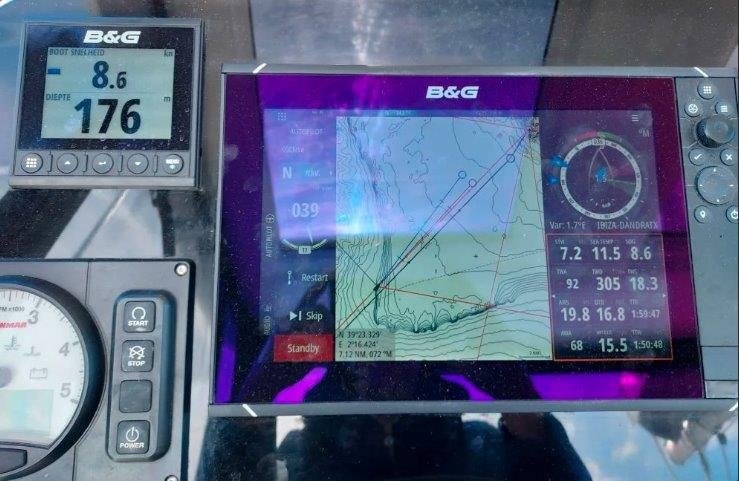
We have sometimes experienced a boat drifting. There are infamous areas, such as The Alderney Race or Strait of Gibraltar, especially with the large tidal differences on the Atlantic Ocean, where at a speed of 5 knots per hour you have a countercurrent of 6 knots. Then your boat slowly moves in a direction that you probably don’t want. Of course the other way around is: 2 knots of current is wonderful if it pushes you in the right direction! We have learned to appreciate and respect the forces of mother nature.
9. Air fryer
Yes, it really needs to be mentioned here. We enjoy our Airfryer and our dishwasher very much. Of course you can live without it. But sometimes heating up pizza or making fish sticks is wonderfully easy.

Or after a BBQ with 6 people, all greasy plates and cutlery were spick and span clean in less than 30 minutes and with a maximum of 6 liters, which is also nice!
At first we didn’t have a dishwasher when we bought the catamaran in 2019. In that year we also started receiving groups for training on the boat. We thought: then we can talk and evaluate together while doing the dishes. Very romantic, but with 12 people (first coffee and cake (washing up), then a lunch with cups and cutlery (washing up) and then the BBQ (washing up again), you will be fed up after 4 groups. And the evaluation will no longer be pleasant either 😉. The dishwasher has been a great investment.
10. Anchor
Our anchor is our great pride! We first had the standard anchor that comes with the boat. That is a DELTA 20. A good anchor, 20 kilograms and good to have for an empty boat (11 tons). But our boat quickly became heavier (think of the tool boxes and the air fryer on it 😉), so our anchor started to scratch. And just like a watch that doesn’t always tell the time correctly: you lose confidence in that tool.
An anchor it is even more important: you don’t want the ship to get adrift at night in strong winds with a beach nearby or worse, rocks. You can prevent a lot with an anchor alarm (which goes off if you start to end up more than 10 meters from the starting point on the GPS), but with the high port fees in areas such as Ibiza, Mallorca or Sardinia, we thought: a good anchor pays for itself.
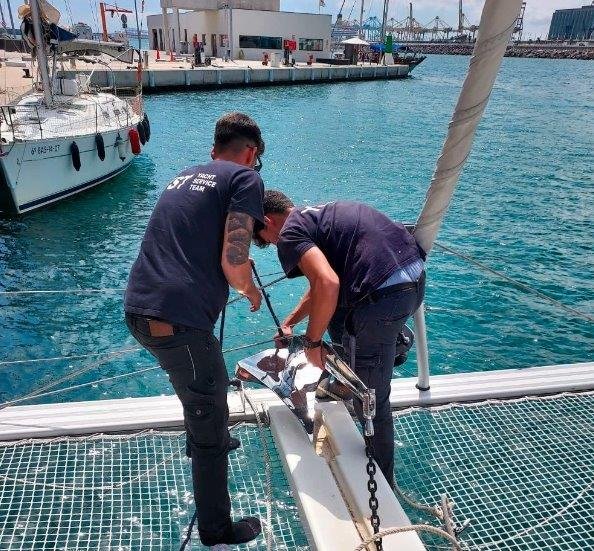
Now we have the Ferrari under the anchors: an Ultra Marine 35, so 35 kg and stainless steel. We bought this at the Port of Barcelona and had it installed and it has never disappointed us! In strong winds it works well, if the anchor starts to drift, it only digs itself deeper. Even on poor surfaces (not firm sand, but mud or grass) the anchor remains firmly in place. This gives us peace of mind, confidence and saves us port fees.


